 General
General  General Archive
General Archive  Blast From the Past: Gerry Cheevers and the Cleveland Crusaders
Blast From the Past: Gerry Cheevers and the Cleveland Crusaders
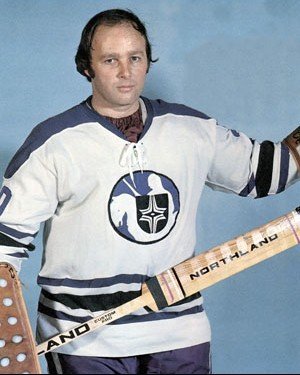 It’s one of the rich images of baseball: a ten-year-old, listening to games on a transistor radio, during times when he should not be doing so. For example, during the school day, or in bed after lights-out. I was that youngster, back in the day. Only, during winter, I was likely to be hiding the radio under the pillow while listening to Steve Albert (brother of Marv and Kenny). My team: the Cleveland Crusaders.
It’s one of the rich images of baseball: a ten-year-old, listening to games on a transistor radio, during times when he should not be doing so. For example, during the school day, or in bed after lights-out. I was that youngster, back in the day. Only, during winter, I was likely to be hiding the radio under the pillow while listening to Steve Albert (brother of Marv and Kenny). My team: the Cleveland Crusaders.
As with much of the late 20th century sports landscape in Cleveland, the Crusaders were the product of the vision and effort of noted local sports tycoon, Nick Mileti. Mileti has been hailed as a local hero, receiving credit for helping to keep the Cleveland Indians from moving in the 1970s. Markets such as Seattle and New Orleans were prepared to "baltimore" the Tribe. Mileti built the Coliseum in Richfield, a very nice venue for concerts and sporting events, and which emphasized the quality of individual seats vs. the corporate loges. The “Big House on the Prairie”, as it was known, was in the middle of a, uh, prairie, south of Cleveland and accessible to Akron and Columbus as well.
Mileti owned the Cleveland Barons, which had had decades of International Hockey League success. This was during the days of the “original six” NHL teams: the Montreal Canadiens, Toronto Maple Leafs, Detroit Red Wings, Boston Bruins, New York Rangers, and the Chicago Blackhawks. Not actually the exact original teams or team names, but these were the traditional NHL franchises. They formed the backbone of the league into the 1970s.
The Barons had sufficient talent- and paid its players accordingly- that its status as a minor league team was not indicative of the quality of the franchise. The Barons’ history, as with its core fan base, was solid.
I admire Nick Mileti. He championed the basketball and baseball franchises many of us live our lives by today. But the Lake Erie Monsters notwithstanding: I blame Nick Mileti for killing professional hockey in Cleveland.
He didn’t mean to; his intent was to take Cleveland hockey to the next level. When the World Hockey Association was to begin its inaugural season in 1972 (just a couple of years after Mileti had created the NBA expansion Cleveland Cavaliers), the Calgary Broncos franchise immediately folded. Nick Mileti stepped in and formed the Cleveland Crusaders in its place. At once, local interest in the Cleveland Barons evaporated into thin air. They moved to Jacksonville, Florida, and folded after one year there.
The upstart WHA was creating a lot of buzz throughout the U.S. and Canada by featuring some of hockey’s biggest stars. Bobby Hull with the Winnipeg Jets. Forty-four year old Gordie Howe and sons Marty and Mark with the Houston Aeros. And in Gerry Cheevers, Nick Mileti had lured one of the best hockey players in the world to Cleveland, to tend goal for the Crusaders.
Like almost all professional hockey players of his day, “Cheesy” was a product of his hockey-ingrained Canadian upbringing. He spent his early years following the Maple Leafs in his home province of Ontario.
As an aside, I have a personal gauge for the level of passion held by a fan base. If they are said to have the "fever", their interest ebbs and flows with the success of the team. "Indians Fever"? Yeah. You won't- or shouldn't- ever hear the term, "Cleveland Browns Fever". I'll be here to smack that one away. That's as absurd as, say, "Cincinnati Bengals Nation" at the other end of the spectrum.
And of course Canada will never need to catch "hockey fever".
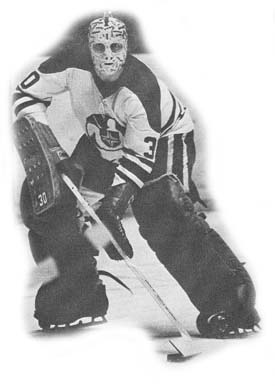 While in the developmental leagues, Gerry Cheevers developed the playing style that was identified with him throughout his career. A good skater, he showed a preference for leaving the crease to rush an oncoming shooter- he liked to take away the angle for a shot. His coaches didn’t appreciate him straying from the net, and he was inserted as a forward for a time to drive that point home. Cheevers later laughed about that. He acknowledged that when opposing players had strayed too close to the net, he often smacked them with his stick- even back in his youth. So he felt vulnerable to payback when the coaches played him on the wing! Actually, he’s said he wouldn’t have minded playing other positions, but he was not a good puck handler. He was excellent at protecting leads as a goalie, and has had a lifelong reputation as a “flopper”- he was never afraid to dive and sprawl out on the ice to make saves. In fact, one of his early coaches made him practice goaltending without a stick, which helped Cheevers develop into a star.
While in the developmental leagues, Gerry Cheevers developed the playing style that was identified with him throughout his career. A good skater, he showed a preference for leaving the crease to rush an oncoming shooter- he liked to take away the angle for a shot. His coaches didn’t appreciate him straying from the net, and he was inserted as a forward for a time to drive that point home. Cheevers later laughed about that. He acknowledged that when opposing players had strayed too close to the net, he often smacked them with his stick- even back in his youth. So he felt vulnerable to payback when the coaches played him on the wing! Actually, he’s said he wouldn’t have minded playing other positions, but he was not a good puck handler. He was excellent at protecting leads as a goalie, and has had a lifelong reputation as a “flopper”- he was never afraid to dive and sprawl out on the ice to make saves. In fact, one of his early coaches made him practice goaltending without a stick, which helped Cheevers develop into a star.
Toronto was the first NHL team to own his rights, in the mid 1960s. At the time, they featured the legendary “China Wall”, Johnny Bower- who had earlier been a long-time star of the Cleveland Barons.
In 1965, the Boston Bruins drafted Cheevers from the Leafs. He was their starting goalie by 1967, and as players such as Bobby Orr and Phil Esposito joined the team, they began to dominate. They won the Stanley Cup in 1970 and 1972. Cheevers and others have gone on record as saying they actually should have won more Cups.
It was while with the Bruins that Gerry Cheevers began to wear the goalie mask that became his signature.
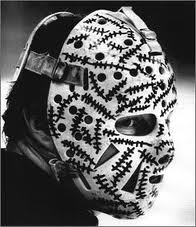 He got hit in the mask with a puck during a practice, and later said it was not a really a sharply struck shot at all- but it was an excuse to call over the trainer and get an escort to the locker room. Cheevers disliked practice. While he was lounging with a beer and a cigarette, a coach walked in to check on him. When Cheevers was told to get back out on the ice, he asked the trainer to put a line on his mask with a magic marker, to show the seriousness of the blow. This quickly developed into a routine of marking the mask whenever it was struck, guessing at the number of stitches it would have caused and illustrating them (Cheevers has also said that he welcomed any way to keep from wearing a white mask; the color symbolized ‘purity‘ to him and he did not want to be associated with that). There was also a practical alteration to the mask; Cheevers had trouble seeing the ice with the small eye holes and had them widened. This became standard practice throughout the league. Cheevers’ original marked-up mask was the one he used for almost his entire hockey career from that point on. It is said his grandson currently has it on display at his home.
He got hit in the mask with a puck during a practice, and later said it was not a really a sharply struck shot at all- but it was an excuse to call over the trainer and get an escort to the locker room. Cheevers disliked practice. While he was lounging with a beer and a cigarette, a coach walked in to check on him. When Cheevers was told to get back out on the ice, he asked the trainer to put a line on his mask with a magic marker, to show the seriousness of the blow. This quickly developed into a routine of marking the mask whenever it was struck, guessing at the number of stitches it would have caused and illustrating them (Cheevers has also said that he welcomed any way to keep from wearing a white mask; the color symbolized ‘purity‘ to him and he did not want to be associated with that). There was also a practical alteration to the mask; Cheevers had trouble seeing the ice with the small eye holes and had them widened. This became standard practice throughout the league. Cheevers’ original marked-up mask was the one he used for almost his entire hockey career from that point on. It is said his grandson currently has it on display at his home.
In the fall of 1972, Nick Mileti and the WHA came calling. They made him a generous contract offer, and Boston would not budge on salary. With the Crusaders, Gerry Cheevers immediately looked like he was in complete control of the team’s fortunes, bearing his trademark number 30 and the mask with the stitch marks. With his experience among relative youngsters (and not to mention his contract), he was basically a player-assistant coach. The team was good, too (resulting in some Crusader Fever!). Former longtime Baron Bill Needham was the head coach, and for a couple years, they battled the New England Whalers for the Eastern Division championship. There was a nice little rivalry brewing for a time (Cheevers had actually been taken by New England in the first WHA draft, but they traded him to Cleveland prior to the first season). Gerry Cheevers was named First Team All-Star in 1973 and Second Team in 1974 and 1975.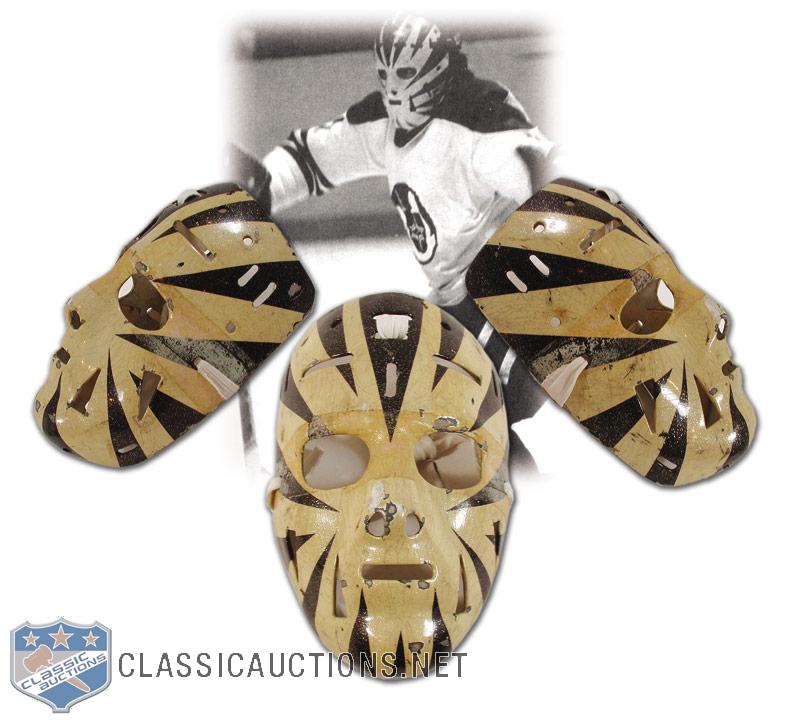
Bob Whidden was Cheevers’ backup, and he was a quality goalie in his own right. Also a Toronto-area guy, he remains friends with Cheevers. Whidden remained in Cleveland long after the WHA era passed, building a hockey dynasty as coach of the St. Edward High School Eagles. He passed that legacy to his son, Rob, who currently coaches the team. (Whidden had his own facemask design for a time - photo.)
In 1974, Gerry Cheevers found himself in the middle of a money crunch with the suddenly struggling Crusaders- who had just moved from the old Cleveland Arena to the new Coliseum. Boston wanted him back, and he agreed. To this day, he speaks fondly of his WHA era. He is proud that as a result of that league, international players became commonplace in the NHL- and salaries grew.
The Cleveland Crusaders lasted until 1976. They moved to Minnesota, and merged with the North Stars to become the NHL Minnesota Fighting Saints. The Crusaders were hastily replaced by the NHL's financially distressed California Golden Seals franchise. That team became a new incarnation of the Cleveland Barons. It lasted for two seasons, suffering from a lack of public promotion- along with its poor financial position. So now, Mileti’s experiment had resulted in the death of the original Barons and now the move of the Crusaders, ultimately resulting in the Cleveland market being left without a strong hockey franchise
OK: to be fair, the WHA’s very existence drained talent from all of minor league hockey, not to mention the NHL. If the original Barons had still been in existence, the hockey landscape would have been different from the past. Crusaders or no Crusaders.
After his playing days, Gerry Cheevers pursued other interests: Horse racing (he’d been spoiled with a great horse early on; when that horse became injured he gave up that sport). Coaching hockey (interesting, mainly due to his reluctance to practice as a player). Scouting hockey. Color commentating on hockey broadcasts. Even WWE wrestling, for a short time.
Although contrary to what many in New England may believe, not everything in sports begins and ends there (try telling a Red Sox fan the truth about Manny Ramirez: that “Manny being Manny“ was a term coined in Cleveland by manager Mike Hargrove- not by them). But truth be told, Gerry Cheevers surely “is” a Boston Bruin. Even so, his time in Cleveland, as a top goalie during the prime of his career, was an era to relish. Especially for a ten-year-old struggling to stay awake past his bedtime during those tense matchups with the Whalers.
Thank you for reading.
YouTube Alerts:
Cheevers and the Crusaders at the Cleveland Arena.
Basically a hockey primer. Includes Pete Franklin’s voice for a bit, and footage of Steve Albert announcing.
http://www.youtube.com/watch?v=FU6Q_jCF4wI
2nd link begins with Cheevers in locker room sitting with Bob Whidden.
Great in-game illustration of his role as basically a playing coach.
See what happens at 3:00 with opposing player.
http://www.youtube.com/watch?v=D4S4dsknC2U
Also:
Chixdiggit’s song, “(I Feel Like) Gerry Cheevers (Stitch Marks on my Heart)”
Photos, including a Crusaders photo at 2:08:
http://www.youtube.com/watch?v=t1trBK0qbzU
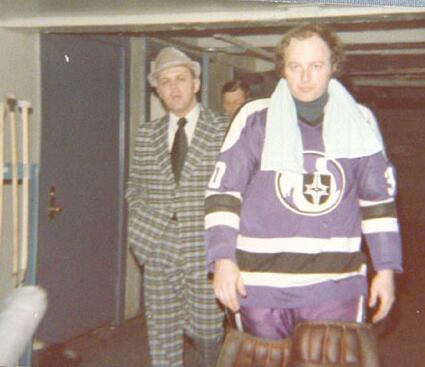
- NBA Announces 2013-2014 Schedule
- Browns Ink Sharknado
- Sharknado A No-Show For Rookie Camp
- Trent Richardson Out Until Training Camp
- Browns Sign Brandon Jackson
- Carrasco Suspended Eight Games
- Browns Add to Wide Receiver Depth with David Nelson
- Browns Need to Learn from Past Draft Mistakes
- Browns Release Chris Gocong and Usama Young
- Browns Missing on Grimes Disappointing, But Not The End
The TCF Forums
- Official- Browns Coach Search/Rumors
mattvan1 (Tuesday, January 21 2014 1:19 PM) - Movies coming out
rebelwithoutaclue (Tuesday, January 21 2014 12:56 PM) - 2015 Recruiting
jclvd_23 (Tuesday, January 21 2014 12:38 PM) - The 2014 Offseason Thread
Larvell Blanks (Tuesday, January 21 2014 12:25 PM) - Chris Grant's first 3 drafts
Kingpin74 (Tuesday, January 21 2014 10:13 AM) - Mike Brown
YahooFanChicago (Monday, January 20 2014 11:15 PM) - 2014 Hoops Hockey Hijinx
jpd1224 (Monday, January 20 2014 4:44 PM) - 2014 Recruiting
jclvd_23 (Monday, January 20 2014 2:26 PM) - Wish List - #4 Pick
Hikohadon (Monday, January 20 2014 1:26 PM) - #1 overall pick Anthony Bennett
TouchEmAllTime (Sunday, January 19 2014 1:28 PM)


